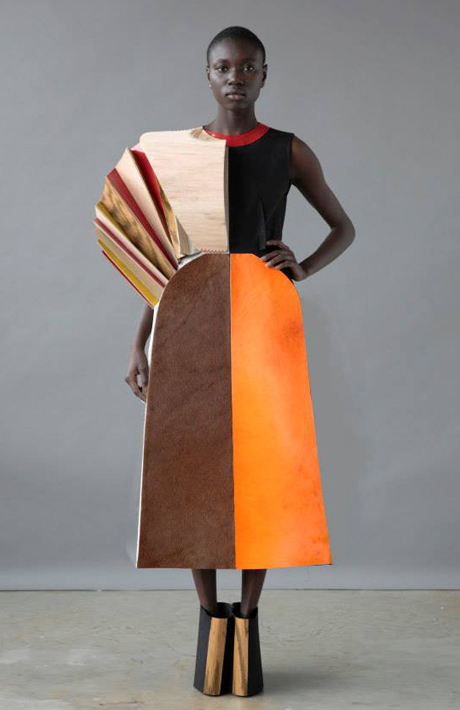Scroll down for english text.
La collezione di Kim Shui esplora l’astrazione del corpo per ricontestualizzare la forma femminile. Come ha detto Ellsworth Kelly “Penso che se puoi spegnere per un attimo la mente e guardare solo attraverso gli occhi alla fine tutto diventa astratto.” Riportando tutto alla forma più basic e pura, il corpo è rimosso dalla metafora e dall’associazione. È una forma umana senza peso, libertà nello spazio e prospettiva – “Il grado zero della forma”.
Ispirata dai quadri di Malevich e dagli schizzi dove la forma umana è distorta, i tessuti ricreano queste forme attraverso i bordi. Ci sono aree di spazio e di spazi vuoti, convessità e concavità per ingannare l’occhio di chi guarda abituato alle classiche definizioni di spazio e forma.
Attraverso le aperture e i “buchi” e le parti piane, ci sono prospettive infinite da tutti gli angoli del corpo. In alcuni lavori di Malevich, lo sfondo o il paesaggio e la figura umana sono trattati allo stesso modo e c’è un certo ritmo geometrico e una ripetizione delle forme. Queste geometrie lineari vengono spiegate attraverso il contrasto fra forma e anti-forma attraverso i tessuti e le pieghe dei materiali.
Il compensato è stato scelto per la sua caratteristica di essere e rappresentare il “vuoto” e per la sua mancanza di connotazioni nella storia dell’arte, è stato in questo caso piegato e modellato per tenere il tessuto intrappolato in nuove forme.
Tessuti di origine vegetale e animale come la pelle sono usati per esaltare la purezza e la connessione con la terra.
Alla fine il corpo femminile è estrapolato e liberato dalla metafora, deviando dagli ideali culturali i tessuti e i materiali reagiscono contro le forme e le proporzioni universalmente accettate culturalmente.
The collection explores abstraction of the body to re-contextualize feminine form. As Ellsworth Kelly said “I think that if you can turn off the mind and look only with the eyes, ultimately everything becomes abstract.” By bringing everything back to the most basic and pure form, the body is removed from metaphor and association. It is human form without weight, freedom of space and perspective – “Zero of form”.
Inspired by Malevich paintings and sketches where the human form is distorted, the garments recreated these forms through outlining. There are areas of space and empty space, convexity and concavity so as to confuse the viewer to the expected relative locations of form and space.
Via “holing” and flatness, There are different perspectives from all angles of the body. In some of Malevich’s work, the background or landscape and the human figure are treated in much the same way, and there is a certain geometric rhythm and repetition of forms. These linear geometries were explained through a contrast of form and anti form via the garments through falling pleats.
Plywood, chosen for its “blankness”, for its lack of artistic connotations and meaning in art history was bent and molded in order to hold fabric into new shapes. Linens, Animal hide and leathers were used to emphasize the rawness, the deliberate connection to the earth. In essence, the female body is stripped away from metaphor – deviating from cultural ideals the garments react against accepted forms and proportions.





Comments are off this post!